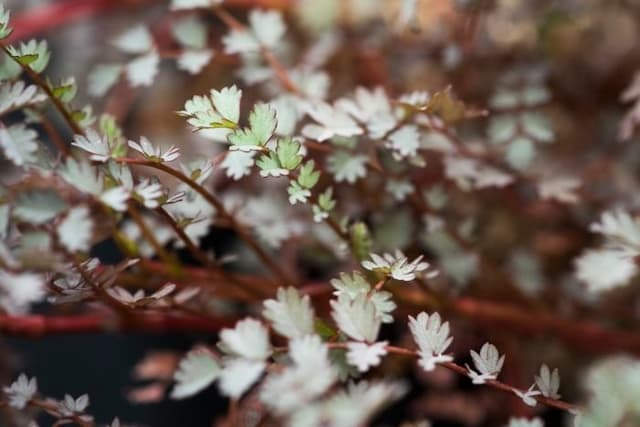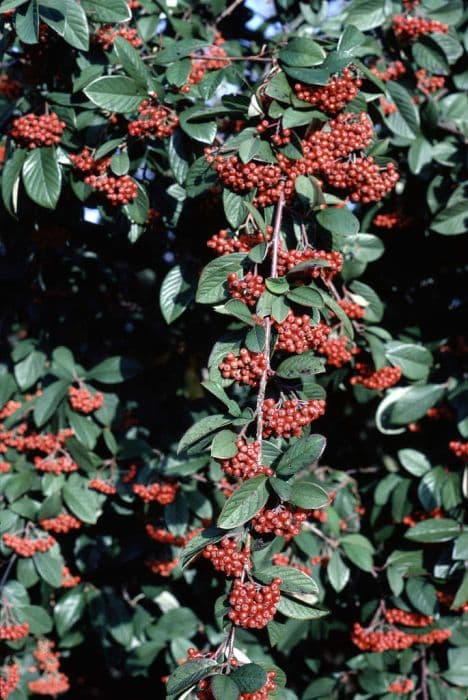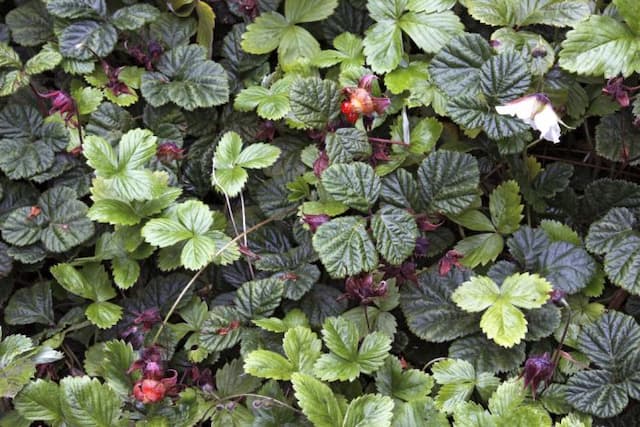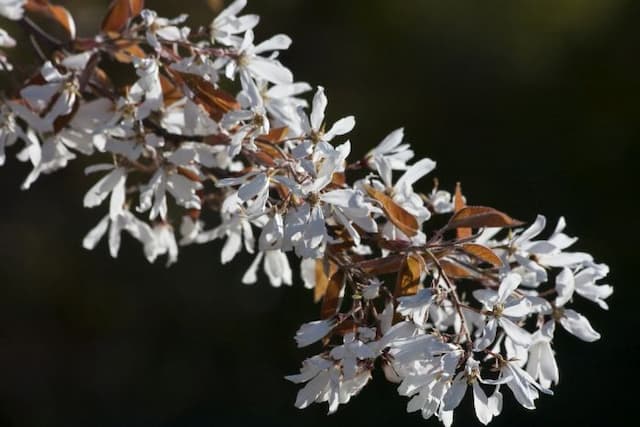European Crab Apple Malus sylvestris

ABOUT
Malus sylvestris, commonly known as the European crab apple, is a deciduous tree recognized by its charming appearance. In spring, the plant adorns itself with a flush of beautiful blossoms, which are typically white with a slight pink hue, exuding a gentle and welcoming fragrance. These pretty flowers stand out against the backdrop of the tree's foliage, consisting of small to medium-sized leaves that are typically green and may have a hint of a silvery underside, giving a shimmery effect when caught by the light. As the seasons turn, the European crab apple undergoes a spectacular transformation. The flowers develop into small apples, which, depending on the particular tree, can range in color from yellow to red; these apples are generally more tart than the domestic apples commonly found in grocery stores. These fruits are not just visually appealing but also form an essential food source for wildlife, attracting birds and small mammals. The tree's bark adds to its character, often appearing rugged with a patterned texture that provides a sturdy-looking frame for the bountiful foliage and fruit. Overall, the European crab apple carries a natural elegance, with its seasonal displays of blooms, fruit, and lush leaves offering a year-round visual interest that makes it a cherished addition to its natural habitat across Europe.
About this plant
 Names
NamesFamily
Rosaceae
Synonyms
European Wild Apple, European Crab Apple
Common names
Malus acerba, Malus communis, Malus praecox, Malus sylvestris var. praecox, Pyrus acerba, Pyrus malus.
 Toxicity
ToxicityTo humans
Malus sylvestris, commonly known as European crab apple, is generally not considered toxic to humans. The fruit of the tree is edible. However, the seeds within the apple, similar to other apples, do contain cyanogenic glycosides, which can release cyanide when chewed and metabolized. It's important to note, though, that accidental ingestion of a few seeds is unlikely to cause harm due to the low concentration of toxins and the body's capacity to detoxify small amounts of cyanide. Consuming a large number of seeds, though, could potentially lead to cyanide poisoning, whose symptoms include headache, dizziness, confusion, anxiety, vomiting, difficulty breathing, and in extreme cases, seizures, loss of consciousness, or even death due to respiratory failure.
To pets
Malus sylvestris, known as the European crab apple, has fruit that is not typically poisonous to pets, including dogs and cats. The seeds, however, do contain small amounts of cyanogenic glycosides, which can be harmful if ingested in large quantities, but due to the low concentration, poisoning is rare. If a pet does consume a substantial amount of seeds and the glycosides within are metabolized into cyanide, the symptoms can include salivation, dilated pupils, difficulty breathing, panting, shock, and in severe cases, seizures or collapse. Long-term effects or death are unlikely unless a very large amount of seeds have been ingested.
 Characteristics
CharacteristicsLife cycle
Perennials
Foliage type
Deciduous
Color of leaves
Green
Flower color
White
Height
15 feet (4.57 meters)
Spread
15 feet (4.57 meters)
Plant type
Tree
Hardiness zones
4-8
Native area
Europe
Benefits
 General Benefits
General Benefits- Wildlife Habitat: Provides food and shelter for birds and other wildlife.
- Ornamental Value: Adds aesthetic appeal to landscapes with its blossoms and fruit.
- Local Cuisine: Fruit can be used in traditional recipes and cider making.
- Pollination: Flowers attract bees and other pollinators, supporting local ecosystems.
- Soil Improvement: Leaf litter and decomposing organic matter can enhance soil fertility.
- Erosion Control: Root systems help stabilize soil and prevent erosion.
- Cultural Significance: Often associated with folklore and history in various cultures.
- Educational Use: Can be used in educational settings to teach about plant biology and ecology.
 Medical Properties
Medical Properties- Diarrhea relief: The fruit of the European crab apple (Malus sylvestris) has been traditionally used to help treat diarrhea.
- Antioxidant source: European crab apple contains antioxidants, which may help protect the body from oxidative stress.
- Astringent effects: The tannins present in the bark may have astringent properties, which can help to tighten and tone tissues.
- Anti-inflammatory properties: The European crab apple may possess anti-inflammatory effects, potentially aiding in the reduction of inflammation.
- Stomach tonic: It has been used to help improve overall stomach health.
 Air-purifying Qualities
Air-purifying QualitiesThis plant is not specifically known for air purifying qualities.
 Other Uses
Other Uses- Woodworking - The dense, hard wood of the European crabapple is valued for fine woodworking and can be used to make furniture, tools, and carved objects.
- Rootstock for grafting - European crabapple is often used as a sturdy rootstock onto which more delicate or specialized apple varieties are grafted.
- Landscape design - Because of its appealing spring blossoms and small, colorful fruit, European crabapple trees are popular in ornamental gardening and landscapes.
- Wildlife habitat - The trees provide shelter and food for birds, insects, and other wildlife in their native woodlands.
- Ink dye - Historically, the tannin-rich bark and fruit were used to make natural dyes for inks.
- Floral arrangements - Branches with buds, blossoms or small fruits are often used in decorative floral arrangements.
- Wood fuel - The wood can be used as a source of fuel for fires, providing heat and a pleasant aroma when burned.
- Culinary vinegar - The acidic fruits can be used to make a tart, flavorful vinegar for culinary purposes.
- Photography - The distinctive flowers and fruits make them an excellent subject for nature photography and botanical illustration.
- Craft Materials - The small, hard fruits can be dried and used in craft projects, like wreath making or as natural beads for jewelry.
Interesting Facts
 Feng Shui
Feng ShuiThe Wild Apple is not used in Feng Shui practice.
 Zodiac Sign Compitability
Zodiac Sign CompitabilityThe Wild Apple is not used in astrology practice.
 Plant Symbolism
Plant Symbolism- Love and Romance: As a member of the rose family, European Crab Apple is often associated with love and matters of the heart, making it a symbol of romance.
- Beauty and Fertility: Its attractive blossoms and the ability to bear fruit signify beauty, fertility, and renewal.
- Peace and Harmony: The European Crab Apple has been used in history as a symbol of peace and resolution of conflict, especially when planted in sacred spaces or near conflict zones.
- Healing and Rejuvenation: In folklore, the European Crab Apple is connected to healing properties, both physical and spiritual, representing rejuvenation and the healing of old wounds.
- Knowledge and Wisdom: With its apple-like fruits, it harks back to the symbol of knowledge and wisdom in various mythologies, like the Norse and Christian traditions linking apples to enlightenment and understanding.
 Water
WaterThe common name for Malus sylvestris is the European crabapple. It should be watered deeply once a week during its growing season, and less frequently during the winter when the tree is dormant. The amount of water required will depend on the soil conditions and weather, but a general rule is to provide about 1 to 2 gallons per week for young trees. Mature trees will need more, around 2 to 4 gallons, especially during long dry spells. The water should be applied slowly to allow deep soil penetration, which encourages deeper root growth and greater drought tolerance.
 Light
LightThe European crabapple thrives best in full sun exposure. They perform optimally when planted in a spot where they receive at least 6 hours of direct sunlight every day. These trees can tolerate light shade but their flowering and fruiting potential may be reduced in less than full sun conditions.
 Temperature
TemperatureThe European crabapple is adaptable to a wide range of temperatures. It can withstand winter lows down to around -30°F and summer highs well above 90°F. However, the ideal growing temperatures are between 60°F and 75°F. The tree may experience stress if temperatures go below the winter low threshold or above the summer high.
 Pruning
PruningPruning the European crabapple is important for maintaining tree health, removing dead or diseased wood, and shaping the tree. Prune in late winter or early spring before new growth starts. Thinning out crowded branches every 2-3 years helps to increase sunlight exposure and air circulation, which can reduce disease problems. The best time for major pruning is when the tree is dormant.
 Cleaning
CleaningAs needed
 Soil
SoilThe European Crab Apple (Malus sylvestris) thrives in well-drained, loamy soil with a pH range of 6.0 to 7.0. For the best results, make a mix of two parts loam, one part sand, and one part compost to provide good drainage and fertility. Regularly test soil pH to maintain the optimal range.
 Repotting
RepottingEuropean Crab Apples (Malus sylvestris) are typically not grown in containers and thus do not require repotting. These trees are best planted directly in the ground where they have space to develop a strong root system.
 Humidity & Misting
Humidity & MistingEuropean Crab Apple (Malus sylvestris) tolerates a wide range of humidity conditions and does well outdoors where the humidity naturally fluctuates. No specific humidity level is essential for this hardy tree.
 Suitable locations
Suitable locationsIndoor
Grow European Crab Apple in bright light, cool temps.
Outdoor
Plant in full sun, well-drained soil, water regularly.
Hardiness zone
4-8 USDA
 Life cycle
Life cycleMalus sylvestris, commonly known as the European crab apple, begins its life as a seed, typically germinating in spring when soil temperatures warm. The germinated seed grows into a seedling, developing roots, a shoot, and embryonic leaves. As the seedling matures into a sapling, it establishes a more extensive root system and produces true leaves and begins to photosynthesize to support further growth. The tree reaches maturity after several years and starts to flower, with pollination leading to fruit production; the fruit contains seeds that complete the lifecycle when they fall to the ground and potentially germinate into new plants. The European crab apple can also propagate clonally through root suckers, which can lead to the formation of dense thickets. Throughout its life, from a seedling to a fully mature tree, it undergoes seasonal cycles of growth, flowering, and fruiting, typically living for many decades.
 Propogation
PropogationPropogation time
Spring-Early Summer
The most popular method of propagation for the European crabapple, Malus sylvestris, is by seed sowing. To propagate by seed, collect the fruits in the fall and extract the seeds from the core. After extraction, the seeds require a period of cold stratification to break dormancy; this is typically accomplished by mixing the seeds with slightly moist sand and storing them in a refrigerator at 34-40°F (1-4°C) for 1-3 months. Once stratified, the seeds can be sown in well-drained soil in either fall or early spring. Seedlings will emerge when the conditions are favorable, usually within a few weeks to two months, depending on the temperature and moisture of the soil. Patience is crucial as it may take several years for the seedlings to grow into fruit-bearing trees.









